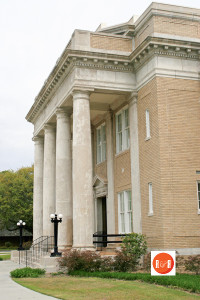The Yorkville Enquirer of Oct. 17, 1872 – “The construction of the Port Royal railroad is now progressing rapidly. Regular train service has been extended to Allendale, sixty miles from Beaufort.”
City Directories and History: The Allendale County Courthouse, constructed in 1921-1922, is significant as the county’s first and only courthouse. Allendale County, the last county established in South Carolina, emerged in 1919 from parts of Barnwell and Hampton counties, jurisdictions thought at the time to be too large to govern effectively. Plans for a courthouse actually began with the legislative act establishing Allendale County; therefore, this courthouse is not merely the only extant building in the county tied closely to the county’s founding but clearly the most significant public building in the county. It is also important as an example of the public design work in South Carolina of G. Lloyd Preacher, noted Augusta and Atlanta architect and native son of Allendale County. The A.J. Krebs and Company, general contractors of Atlanta, was engaged to carry out the building’s construction. The

Images courtesy of photographer Bill Segars – 2008



 courthouse is a two-story yellow brick and limestone-accented building whose central block with pedestaled pediment is dominated by a monumental, unengaged, flat-roofed Neoclassical Revival portico. The portico features four massive limestone columns and responding pilasters of the Tuscan order, a classical entablature, and a brick and limestone parapet. Immediately to the rear [northeast] and connected to the historic courthouse by a narrow two-story hyphen is a large office and courtroom building that was completed and occupied in 2004. The new building’s construction was part of a larger project that included the overall reconstruction of the historic courthouse’s interior and rehabilitation of its exterior, following a devastating arson fire that destroyed much the building’s interior on the morning of May 18, 1998. The interior’s restoration, in plan and detail, is based upon the 1921 architectural drawings by G. Lloyd Preacher and Company. Listed in the National Register August 1, 2007. [Courtesy of the SC Dept. of Archives and History]
courthouse is a two-story yellow brick and limestone-accented building whose central block with pedestaled pediment is dominated by a monumental, unengaged, flat-roofed Neoclassical Revival portico. The portico features four massive limestone columns and responding pilasters of the Tuscan order, a classical entablature, and a brick and limestone parapet. Immediately to the rear [northeast] and connected to the historic courthouse by a narrow two-story hyphen is a large office and courtroom building that was completed and occupied in 2004. The new building’s construction was part of a larger project that included the overall reconstruction of the historic courthouse’s interior and rehabilitation of its exterior, following a devastating arson fire that destroyed much the building’s interior on the morning of May 18, 1998. The interior’s restoration, in plan and detail, is based upon the 1921 architectural drawings by G. Lloyd Preacher and Company. Listed in the National Register August 1, 2007. [Courtesy of the SC Dept. of Archives and History]
Traditionally, the nucleus of towns has been a crossroad, a trading center, a stage coach stop, or probably a wayside inn. However, Allendale’s origin is in striking contrast to the usual. Excerpts from the pen of the late Dr. John Williams Ogilvie, in the Southern Christian Advocate of July 20, 1882, reveal an interesting account of the original town and also the origin of the name, Allen-dale. Prior to the construction of the C. & W. C. Railroad in the approximate year of 1872, there was a post office called Buddenville about five miles away from the present town of Allendale, situated in a southwesterly direction. Buddenville had been named for an educator and foremost citizen in this community. Buddenville Post Office was the center of a region inhabited by large planters and land owners where wealth, affluence, culture and high standards of living were reflected in the palatial homes and surroundings of families living there. Academies of learning, instructors of music, art, and languages were maintained in the community in order to prepare youth for higher educational ad-vantages afforded both within the States and abroad. Also, attesting to the support of religious denominations in this area, are several churches that have with-stood the ravages of time, and also church-yard cemeteries where houses of worship stood. According to Dr. Ogilvie, the nearby railroad caused an influx of people from adjoining areas to settle in the new location, later to be called Allendale. The area surrounding the settlement had been “localized and called Swallow Savannah,” because of its topography. There were also several other nearby areas, similarly named Duck Savannah and Heron Savannah. With the establishment of a post office in this settlement on the new railroad, consideration of a name became a problem. Dr. Ogilvie stated “Swallow Savannah” would not be a good choice because the word was both too long and euphonious, and, as Paul H. Allen was postmaster and also an outstanding citizen, the consensus was that naming the village for him would be most appropriate. Consequently, the name Allen, plus the suffix “dale” resulted in a simple word pleasing to the ear, also. Thus, it was decided to name the place Allendale. Dr. Ogilvie stated: “Paul H. Allen was a pillar in the Swallow Savannah Methodist Church, a staunch supporter of all that was good, as well as being an arch enemy of all that was evil or corrupt.”
Upon Mr. Allen s death, he was buried in Swallow Savannah Cemetery. Many descendants and relatives survived the old gentleman, some of whom are still living here. Dr. Ogilvie, a pioneer of this section, and a con-temporary of Mr. Allen, was a physician of prominence and also an outstanding citizen. He died in 1905. Dr. Ogilvie’s wife was the former Miss Sallie Moye, whose family was also prominent in affairs of their era. The Buddenville section is often designated as Old Allendale by the many people returning to visit the land of their forebears.
(Information from: Names in South Carolina by C.H. Neuffer, Published by the S.C. Dept. of English, USC)
Stay Connected
Explore history, houses, and stories across S.C. Your membership provides you with updates on regional topics, information on historic research, preservation, and monthly feature articles. But remember R&R wants to hear from you and assist in preserving your own family genealogy and memorabilia.
Visit the Southern Queries – Forum to receive assistance in answering questions, discuss genealogy, and enjoy exploring preservation topics with other members. Also listed are several history and genealogical researchers for hire.
User comments welcome — post at the bottom of this page.
Please enjoy this structure and all those listed in Roots and Recall. But remember each is private property. So view them from a distance or from a public area such as the sidewalk or public road.
Do you have information to share and preserve? Family, school, church, or other older photos and stories are welcome. Send them digitally through the “Share Your Story” link, so they too might be posted on Roots and Recall.
Thanks!


